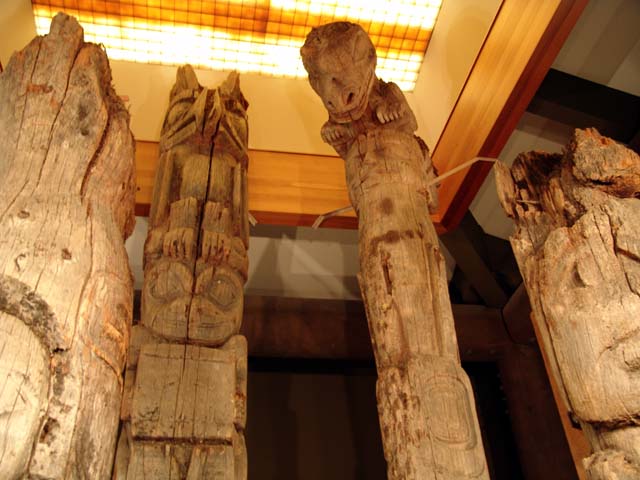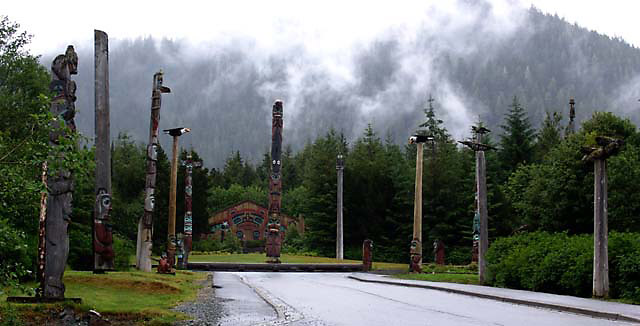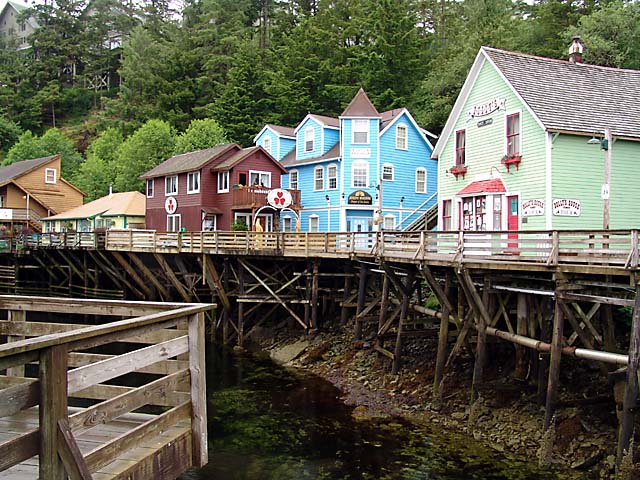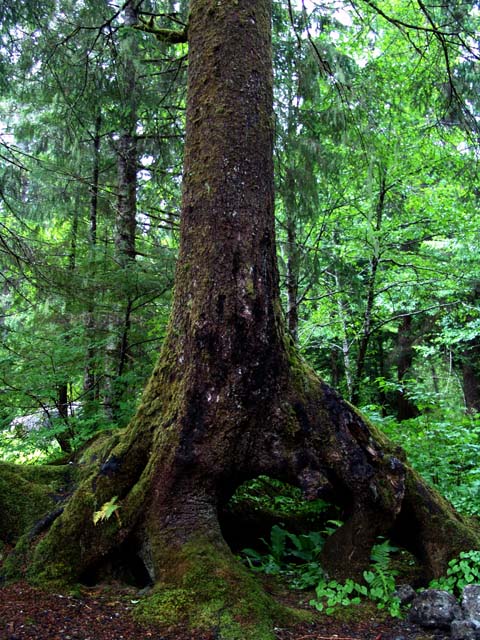
Ketchikan
June 12
Saturday: Got up early (4:45 AM) to catch the ferry to Ketchikan. Don't know why they want us there so early since the ferry doesn't leave until 8:30 AM, but we do as we are told, rather than miss the boat. It was raining, so views of mountain scenery were very limited. The ferry ride was nice since the Forest Service had a ranger on board that gave short talks on the area and wildlife, the inside passage, and Ketchikan, our next stop.

Ketchikan harbor. Ketchikan is hemmed in by water and mountains so it is
strung out along the shore, which makes for a long and narrow town. Note the
cruise ship docked in the background; they are very large. The ship left about 5
PM; they tend to travel at night and dock in towns during the day so everyone
can go shopping - what a waste! How many t-shirts and junky souvenirs does
one need?

Ketchikan is a center for the Native American culture of southeast Alaska,
especially the Tlingit and Haida tribes. The Totem Heritage Center in Ketchikan
has a large collection of old totem poles in a museum setting to preserve them.
Left in their natural setting, totem poles last about 50 years in this climate.
Most of the totem poles that you see in the cities are much newer - 10 to 20
years old. The Heritage Center has poles from Tlingit and Haida villages that
date from about the late 19th and early 20th centuries. Even more interesting
than the poles was their collection of photos showing the villages with the
poles still standing.

Saxman, a village just south of Ketchikan, has a well-known totem pole
collection, but outdoors in a park-like setting. These poles are reproductions
of ancient poles, but carved by the Tlingits. According to what we read, the
totem poles were not objects of worship, but told stories about the history of
the clan, or commemorated important events. Note the totem pole sticking up
behind the trees on the right. It has a likeness of Abe Lincoln. The pole was
carved to commemorate a peace treaty between two warring Tlingit tribes. A US
ship named the "Abraham Lincoln" was instrumental in negotiating the treaty, so
the pole was carved in honor of the ship.

Creek Street is built on pilings above Ketchikan Creek. The street was
Ketchikan's red light district until the 1950s; hence the saying that,
"Creek Street is where salmon and men swim upstream to spawn." Dolly's House, on
the right, was a bordello, but is now a museum; it was closed when we were there
(more bad luck (:-)). Creek Street is now a tourist-oriented shopping district,
with gift shops and art galleries.

It was our 40th wedding anniversary so we rode the funicular car up the hill
to the Westmark Cape Fox hotel for dinner and a view of the Ketchikan harbor.
Will we make it to 41, despite spending 4 months together in our little Roadtrek? Only time will tell! It is hard to believe that we have been gone one
month from home; it seems that we are just starting our Alaska trip. There is
still a lot to see!

Ketchikan receives an average of 160 inches of rain per year, so the forests in the area can be considered rain forests. This tree took root on top of an older tree that had fallen; the roots grew around the trunk on the older tree. The older tree has since rotted away leaving this tree up in the air - on stilts, so to speak.